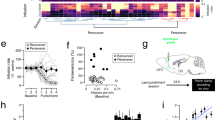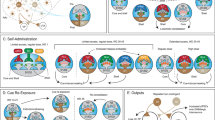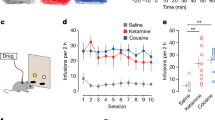Abstract
NMDA receptor-mediated glutamate transmission is required for several forms of neuronal plasticity. Its role in the neuronal responses to addictive drugs is an ongoing subject of investigation. We report here that the acute locomotor-stimulating effect of cocaine is absent in NMDA receptor-deficient mice (NR1-KD). In contrast, their acute responses to amphetamine and to direct dopamine receptor agonists are not significantly altered. The striking attenuation of cocaine's acute effects is not likely explained by alterations in the dopaminergic system of NR1-KD mice, since most parameters of pre- and postsynaptic dopamine function are unchanged. Consistent with the behavioral findings, cocaine induces less c-Fos expression in the striatum of these mice, while amphetamine-induced c-Fos expression is intact. Furthermore, chronic cocaine-induced sensitization and conditioned place preference are attenuated and develop more slowly in mutant animals, but amphetamine's effects are not altered significantly. Our results highlight the importance of NMDA receptor-mediated glutamatergic transmission specifically in cocaine actions, and support a hypothesis that cocaine and amphetamine elicit their effects through differential actions on signaling pathways.
Similar content being viewed by others
Log in or create a free account to read this content
Gain free access to this article, as well as selected content from this journal and more on nature.com
or
References
Amara SG, Kuhar MJ (1993). Neurotransmitter transporters: recent progress. Annu Rev Neurosci 16: 73–93.
Anderson KD, Reiner A (1991). Immunohistochemical localization of DARPP-32 in striatal projection and striatal interneurons: implications for the localization of D1-like dopamine receptors on different types of striatal neurons. Brain Res 568: 235–243.
Badiani A, Oates MM, Day HE, Watson SJ, Akil H, Robinson TE (1998). Amphetamine-induced behavior, dopamine release, and c-fos mRNA expression: modulation by environmental novelty. J Neurosci 18: 10579–10593.
Beattie EC, Carroll RC, Xiang Y, Morishits W, Yasuda H, von Zastrow M et al (2000). Regulation of AMPA receptor endocytosis by a signaling mechanism shared with LTD. Nat Neurosci 3: 1291–1300.
Beurrier C, Malenka RC (2002). Enhanced inhibition of synaptic transmission by dopamine in the nucleus accumbens during behavioral sensitization to cocaine. J Neurosci 22: 5817–5822.
Bibb JA, Chen J, Taylor JR, Svenningsson P, Nishi A, Snyder GL et al (2001). Effects of chronic exposure to cocaine are regulated by the neuronal protein Cdk5. Nature 410: 376–380.
Bonci A, Bernardi G, Grillner P, Mercuri NB (2003). The dopamine-containing neuron: maestro or simple musician in the orchestra of addiction? Trends Pharmacol Sci 24: 172–177.
Bowden C, Theodorou AE, Cheetham SC, Lowther S, Katona CL, Crompton MR et al (1997). Dopamine D1 and D2 receptor binding sites in brain samples from depressed suicides and controls. Brain Res 752: 227–233.
Cenci MA, Björklund A (1993). Transection of corticostriatal afferents reduces amphetamine- and apomorphine-induced striatal Fos expression and turning behaviour in unilaterally 6-hydroxydopamine-lesioned rats. Eur J Neurosci 5: 1062–1070.
Chausmer AL, Katz JL (2001). The role of D2-like dopamine receptors in the locomotor stimulant effects of cocaine in mice. Psychopharmacology 155: 69–77.
Cyr M, Caron MG, Johnson GA, Laakso A (2005). Magnetic resonance imaging at microscopic resolution reveals subtle morphological changes in a mouse model of dopaminergic hyperfunction. Neuroimage 26: 83–90.
Dalia A, Wallace LJ (1995). Amphetamine induction of c-fos in the nucleus accumbens is not inhibited by glutamate antagonists. Brain Res 694: 299–307.
Ehlers MD (2000). Reinsertion or degradation of AMPA receptors determined by activity-dependent endocytic sorting. Neuron 28: 511–525.
Fukaya M, Kato A, Lovett C, Tonegawa S, Watanabe M (2003). Retention of NMDA receptor NR2 subunits in the lumen of endoplasmic reticulum in targeted NR1 knockout mice. Proc Natl Acad Sci USA 100: 4855–4860.
Gainetdinov RR, Wetsel WC, Jones SR, Levin ED, Jaber M, Caron MG (1999). Role of serotonin in the paradoxical calming effect of psychostimulants on hyperactivity. Science 283: 397–401.
Gandolfi O, Dall'Olio R (1993). Chronic treatment with MK-801 decreases D2 dopamine receptor function in rat striatum. Pharmacol Biochem Behav 44: 683–687.
Ganguly A, Keefe KA (2000). Effects of MK-801 on D1 dopamine receptor-mediated immediate early gene expression in the dopamine-depleted striatum. Brain Res 871: 156–159.
Graybiel AM, Moratalla R, Robertson HA (1990). Amphetamine and cocaine induce drug-specific activation of the c-fos gene in striosome-matrix compartments and limbic subdivisions of the striatum. Proc Natl Acad Sci USA 87: 6912–6916.
Greengard P (2001). Neurobiology of slow synaptic transmission. Science 294: 1024–1030.
Haracz JL, Belanger SA, MacDonall JS, Sircar R (1995). Antagonist of N-methyl-D-aspartate receptors partially prevent the development of cocaine sensitization. Life Sci 57: 2347–2357.
Heimer L, Zahm DS, Alheid GF (1995). Basal ganglia.In: Paxinos G (ed). The Rat Nervous System,2nd edn. Academic Press: San Diego. pp 579–628.
Heusner CL, Palmiter RD (2005). Expression of mutant NMDA receptors in dopamine D1 receptor-containing cells prevents cocaine sensitization and decreases cocaine preference. J Neurosci 25: 6651–6657.
Huh KH, Wenthold RJ (1999). Turnover analysis of glutamate receptors identifies a rapidly degraded pool of the N-Methyl-D-aspartate receptor subunit, NR1, in cultured cerebellar granule cells. J Biol Chem 274: 151–157.
Hyman SE, Malenka RC (2001). Addiction and the brain: the neurobiology of compulsion and its persistence. Nat Rev Neurosci 2: 695–703.
Jones SR, Gainetdinov RR, Wightman RM, Caron MG (1998). Mechanisms of amphetamine action revealed in mice lacking the dopamine transporter. J Neurosci 18: 1979–1986.
Kalivas PW, Alesdatter JE (1993). Involvement of N-methyl-D-aspartate receptor stimulation in the ventral tegmental area and amygdala in behavioral sensitization to cocaine. J Pharmacol Exp Ther 267: 486–495.
Karler R, Calder LD (1992). Excitatory amino acids and the actions of cocaine. Brain Res 582: 143–146.
Karler R, Calder LD, Chaudhry IA, Turkanis SA (1989). Blockade of ‘reverse tolerance’ to cocaine and amphetamine by MK-801. Life Sci 45: 599–606.
Kenny PJ, Markou A (2004). The ups and downs of addiction: role of metabotropic glutamate receptors. Trends Pharmacol Sci 25: 265–272.
Konradi C, Leveque JC, Hyman SE (1996). Amphetamine and dopamine-induced immediate early gene expression in striatal neurons depends on postsynaptic NMDA receptors and calcium. J Neurosci 16: 4231–4239.
Koob GF, Sanna PP, Bloom FE (1998). Neuroscience of addiction. Neuron 21: 467–476.
Kuczenski R, Segal DS, Aizenstein ML (1991). Amphetamine, cocaine, and fencamfamine: relationship between locomotor and stereotypy response profiles and caudate and accumbens dopamine dynamics. J Neurosci 11: 2703–2712.
Li Y, Hu XT, Berney TG, Vartanian AJ, Stine CD, Wolf ME et al (1999). Both glutamate receptor antagonists and prefrontal cortex lesions prevent induction of cocaine sensitization and associated neuroadaptations. Synapse 34: 169–180.
Madras BK, Spealman RD, Fahey MA, Neumeyer JL, Saha JK, Milius RA (1989). Cocaine receptors labeled by [3H]2 beta-carbomethoxy-3 beta-(4-fluorophenyl)tropane. Mol Pharmacol 36: 518–524.
Malmberg A, Mohell N (1995). Characterization of [3H]quinpirole binding to human dopamine D2A and D3 receptors: effects of ions and guanine nucleotides. J Pharmacol Exp Ther 274: 790–797.
Medvedev IO, Gainetdinov RR, Sotnikova TD, Bohn LM, Caron MG, Dykstra LA (2005). Characterization of conditioned place preference to cocaine in congenic dopamine transporter knockout female mice. Psychopharmacology 180: 408–413.
Micheletti G, Lannes B, Haby C, Borrelli E, Kempf E, Warter JM et al (1992). Chronic administration of NMDA antagonists induces D2 receptor synthesis in rat striatum. Brain Res Mol Brain Res 14: 363–368.
Miyamoto S, Snouwert JN, Koller BH, Moy SS, Lieberman JA, Duncan GE (2004). Amphetamine-induced Fos is reduced in limbic cortical regions but not in the caudate or accumbens in a genetic model of NMDA receptor hypofunction. Neuropsychopharmacology 29: 2180–2188.
Miyamoto Y, Yamada K, Nagai T, Mori H, Mishina M, Furukawa H et al (2004). Behavioural adaptations to addictive drugs in mice lacking the NMDA receptor epsilon1 subunit. Eur J Neurosci 19: 151–158.
Mohn AR, Gainetdinov RR, Caron MG, Koller BH (1999). Mice with reduced NMDA receptor expression display behaviors related to schizophrenia. Cell 98: 427–436.
Moratalla R, Elibol B, Vallejo M, Graybiel AM (1996a). Network-level changes in expression of inducible Fos-Jun proteins in the striatum during chronic cocaine treatment and withdrawal. Neuron 17: 147–156.
Moratalla R, Xu M, Tonegawa S, Graybiel AM (1996b). Cellular responses to psychomotor stimulant and neuroleptic drugs are abnormal in mice lacking the D1 dopamine receptor. Proc Natl Acad Sci USA 93: 14928–14933.
Morelli M (1997). Dopamine/glutamate interaction as studied by combining turning behaviour and c-fos expression. Neurosci Biobehav Rev 21: 505–510.
Murray F, Kennedy J, Hutson PH, Elliot J, Huscroft I, Mohnen K et al (2000). Modulation of [3H]MK-801 binding to NMDA receptors in vivo and in vitro. Eur J Pharmacol 397: 263–270.
Nestler EJ (2001). Molecular basis of long-term plasticity underlying addiction. Nat Rev Neurosci 2: 119–128.
Paladini CA, Fiorillo CD, Morikawa H, Williams JT (2001). Amphetamine selectively blocks inhibitory glutamate transmission in dopamine neurons. Nat Neurosci 4: 275–281.
Paladini CA, Robinson S, Morikawa H, Williams JT, Palmiter RD (2003). Dopamine controls the firing pattern of dopamine neurons via a network feedback mechanism. Proc Natl Acad Sci USA 100: 2866–2871.
Porrino LJ, Lyons D (2000). Orbital and medial prefrontal cortex and psychostimulant abuse: studies in animal models. Cereb Cortex 10: 326–333.
Post RM, Rose H (1976). Increasing effects of repetitive cocaine administration in the rat. Nature 260: 731–732.
Price GW, Ahier RG, Middlemiss DN, Singh L, Tricklebank MD, Wong EHF (1988). In vivo labelling of the NMDA receptor channel complex by [3H]MK-801. Eur J Pharmacol 158: 279–282.
Ranaldi R, Munn E, Neklesa T, Wise RA (2000). Morphine and amphetamine sensitization in rats demonstrated under moderate- and high-dose NMDA receptor blockade with MK-801 (dizocilpine). Psychopharmacology (Berl) 151: 192–201.
Robinson TE, Kolb B (1997). Persistent structural modifications in nucleus accumbens and prefrontal cortex neurons produced by previous experience with amphetamine. J Neurosci 17: 8491–8497.
Rocha BA, Fumagalli F, Gainetdinov RR, Jones SR, Ator R, Giros B et al (1998). Cocaine self-administration in dopamine-transporter knockout mice. Nat Neurosci 1: 132–137.
Schultz W (1998). Predictive reward signal of dopamine neurons. J Neurophysiol 80: 1–27.
Scott DB, Blanpied TA, Swanson GT, Zhang C, Ehlers MD (2001). An NMDA receptor ER retention signal regulated by phosphorylation and alternative splicing. J Neurosci 21: 3063–3072.
Scott L, Kruse MS, Forssberg H, Brismar H, Greengard P, Aperia A (2002). Selective up-regulation of dopamine D1 receptors in dendritic spines by NMDA receptor activation. Proc Natl Acad Sci USA 99: 1661–1664.
Segal DS, Mandell AJ (1974). Long-term administration of d-amphetamine: progressive augmentation of motor activity and stereotypy. Pharmacol Biochem Behav 2: 249–255.
Snyder EM, Colledge M, Crozier RA, Chen WS, Scott JD, Bear MF (2005). Role for A kinase-anchoring proteins (AKAPS) in glutamate receptor trafficking and long term synaptic depression. J Biol Chem 280: 16962–16968.
Soucy JP, Mrini A, Lafaille F, Doucet G, Descarries L (1997). Comparative evaluation of [3H]WIN 35428 and [3H]GBR 12935 as markers of dopamine innervation density in brain. Synapse 25: 163–175.
Shimizu E, Tang YP, Rampon C, Tsien JZ (2000). NMDA receptor-dependent synaptic reinforcement as a crucial process for memory consolidation. Science 290: 1170–1174.
Stewart J, Druhan JP (1993). Development of both conditioning and sensitization of the behavioral activating effects of amphetamine is blocked by the non-competitive NMDA receptor antagonist, MK-801. Psychopharmacology (Berl) 110: 125–132.
Sulzer D, Sonders MS, Poulsen NW, Galli A (2005). Mechanisms of neurotransmitter release by amphetamines: a review. Prog Neurobiol 75: 406–433.
Tan A, Moratalla R, Lyford GL, Worley P, Graybiel AM (2000). The activity-regulated cytoskeletal-associated protein Arc is expressed in different striosome-matrix patterns following exposure to amphetamine and cocaine. J Neurochem 74: 2074–2078.
Tang YP, Shimizu E, Dabe GR, Rampon C, Kerchner GA, Zhou M et al (1999). Genetic enhancement of learning and memory in mice. Nature 401: 63–69.
Thomas MJ, Beurrier C, Bonci A, Malenka RC (2001). Long-term depression in the nucleus accumbens: a neural correlate of behavioral sensitization to cocaine. Nat Neurosci 4: 1217–1223.
Tsien JZ, Huerta PT, Tonegawa S (1996). The essential role of hippocampal CA1 NMDA receptor-dependent synaptic plasticity in spatial memory. Cell 87: 1327–1338.
Tzschentke TM (2001). Pharmacology and behavioral pharmacology of the mesocortical dopamine system. Prog Neurobiol 63: 241–320.
Tzschentke TM, Schmidt WJ (1998). Does the noncompetitive NMDA receptor antagonist dizocilpine (MK801) really block behavioural sensitization associated with repeated drug administration? Trends Pharmacol Sci 19: 447–451.
Vanderschuren LJMJ, Kalivas PW (2000). Alterations in dopaminergic and glutamatergic transmission in the induction and expression of behavioral sensitization: a critical review of preclinical studies. Psychopharmacology 151: 99–120.
Volkow ND, Fowler JS (2000). Addiction, a disease of compulsion and drive: involvement of the orbitofrontal cortex. Cereb Cortex 10: 318–325.
White FJ (1990). Electrophysiological basis of the reinforcing effects of cocaine. Behav Pharmacol 1: 303–315.
White FJ (2002). A behavioral/systems approach to the neuroscience of drug addiction. J Neurosci 22: 3303–3305.
Wolf ME (1998). The role of excitatory amino acids in behavioral sensitization to psychomotor stimulants. Prog Neurobiol 54: 679–720.
Wolf ME, Jeziorski M (1993). Coadministration of MK-801 with amphetamine, cocaine, or morphine prevents rather than transiently masks the development of behavioral sensitization. Brain Res 613: 291–294.
Xu M, Hu XT, Cooper DC, Moratalla R, Graybiel AM, White FJ et al (1994). Elimination of cocaine-induced hyperactivity and dopamine-mediated neurophysiological effects in dopamine D1 receptor mutant mice. Cell 79: 945–955.
Yao WD, Gainetdinov RR, Arbuckle MI, Sotnikova TD, Cyr M, Beaulieu JM et al (2004). Identification of PSD-95 as a regulator of dopamine-mediated synaptic and behavioral plasticity. Neuron 41: 625–638.
Acknowledgements
We thank Dr Beverly Koller for providing NR1 KD mutant mice. We also thank Julie Harris, Wendy Roberts, and Katherine Clark for excellent technical assistance and Dr Jean Martin Beaulieu for helpful comments. This work was supported in part by a grant from NIH NS19576 (to MGC), NIDA DA02749 (to LAD) and NIDA DA017703 (to AJR). AL was supported in part by Academy of Finland. MC and AS were holders of Fonds de Recherche en Sante du Quebec fellowship, and AS is supported by CIHR.
Author information
Authors and Affiliations
Corresponding author
Additional information
DISCLOSURE/CONFLICT OF INTEREST
MGC receives compensation as a member of the Scientific Advisory Board of Acadia Pharmaceutical and owns stock in the company. He has consulted for Lundbeck and has received compensation. He has also received compensation in the form of honoraria for lecturing at various scientific meetings and academic institutions. None of the above presents any conflicts of interest with the results being described in the present paper.
Rights and permissions
About this article
Cite this article
Ramsey, A., Laakso, A., Cyr, M. et al. Genetic NMDA Receptor Deficiency Disrupts Acute and Chronic Effects of Cocaine but not Amphetamine. Neuropsychopharmacol 33, 2701–2714 (2008). https://doi.org/10.1038/sj.npp.1301663
Received:
Revised:
Accepted:
Published:
Issue date:
DOI: https://doi.org/10.1038/sj.npp.1301663
Keywords
This article is cited by
-
Deficits in integrative NMDA receptors caused by Grin1 disruption can be rescued in adulthood
Neuropsychopharmacology (2023)
-
Ifenprodil Attenuates Methamphetamine-Induced Behavioral Sensitization Through the GluN2B-PP2A-AKT Cascade in the Dorsal Striatum of Mice
Neurochemical Research (2020)
-
Differential effects of aprepitant, a clinically used neurokinin-1 receptor antagonist on the expression of conditioned psychostimulant versus opioid reward
Psychopharmacology (2017)
-
In Vivo Amphetamine Action is Contingent on αCaMKII
Neuropsychopharmacology (2014)
-
Brain-Specific Overexpression of Trace Amine-Associated Receptor 1 Alters Monoaminergic Neurotransmission and Decreases Sensitivity to Amphetamine
Neuropsychopharmacology (2012)



